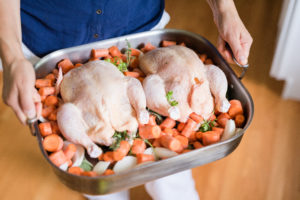 In the past several detox related posts, I have established a very important point… we do not have to feel deprived while we are on a detox! In fact, by avoiding inflammatory foods like gluten and sugar (and others!), we get to still eat some pretty yummy foods. Check out my recent post on detox lunches and breakfast ideas. You’ll find many recipes and fun cooking demo videos that show you how to create some delicious dishes.
In the past several detox related posts, I have established a very important point… we do not have to feel deprived while we are on a detox! In fact, by avoiding inflammatory foods like gluten and sugar (and others!), we get to still eat some pretty yummy foods. Check out my recent post on detox lunches and breakfast ideas. You’ll find many recipes and fun cooking demo videos that show you how to create some delicious dishes.
Now, let’s focus on detox dinners! For many of us, the end of the day is a time to relax and nourish ourselves, especially for those of us that live in a wintry climate where we’ve been battling the cold weather. Ideally, dinner should not be the largest meal of the day because we generally are not very active at the end of the day. But to help us feel rejuvenated, a small but substantial meal can make all the difference after a long day.
 Here are some helpful tips when planning your dinners:
Here are some helpful tips when planning your dinners:
- Think of this dinner plate image in your mind when planning your dinner: 25% clean protein, 50% veggies, 25% starchy veggies, and 1-2 tablespoons of healthy fats. Try to plan your meals with these proportions in mind. If you choose to make a soup or stew, this will help you get a sense of how much protein to add. If weekdays are especially busy, then simple meals are the easiest!
- Plan ahead! If you know you’ll be limited in cooking time, then consider pairing these three items for dinners and try to do your large shopping on the weekend in preparation:
- Protein: Buy enough protein for a dinner and some leftovers for lunch the next day, and get some variety through the week. If you’re shopping on the weekend for the week ahead, buy a few different proteins, in proportions that will give you enough for a dinner and some lunch leftovers. For example, Grass-fed steak or ground beef, organic chicken or poultry, wild fish, organic eggs. Keep in mind that a cut-up chicken or a family pack of chicken breast plus some dark meat will be easier and quicker to cook then a whole chicken. Same goes for buying multiple smaller cuts of grass-fed beef as compared to one larger cut. Eggs are a good option on occasion as well– you can make a frittata or classic Spanish tortilla as the protein.
- Veggies: It’s important to get diversity in vegetables through the week and month. When you do your larger shopping, you can look at what’s fresh and buy enough different veggie portions for the dinners you will be making through the week. For example, you may buy broccoli for one night and kale for another and multi-colored heirloom carrots for a third dinner. Make sure to buy enough for dinner and some leftovers for lunch the next day.
- Starchy Veggies: Carbohydrates are important for a healthy body but by choosing starchy root vegetables as your carb source over grain or legumes will give you more energy. Consider pairing some of these examples with your dinners: mixed sweet potatoes (pink, orange, white, and purple flesh), winter squash like butternut and acorn squash, rutabaga.
- Healthy Fats: Good fats are essential for a healthy body– without them, our body doesn’t have the necessary tools for repair and regeneration. Here are some great sources of healthy fats to pair with your dinner: extra virgin olive oil, olives, extra virgin coconut oil, coconut, avocados and avocado oil, nuts, seeds.
- Check out this great meal planning post!
Here are some great dinner option recipes:
Stay tuned for more dinner recipes to follow soon!